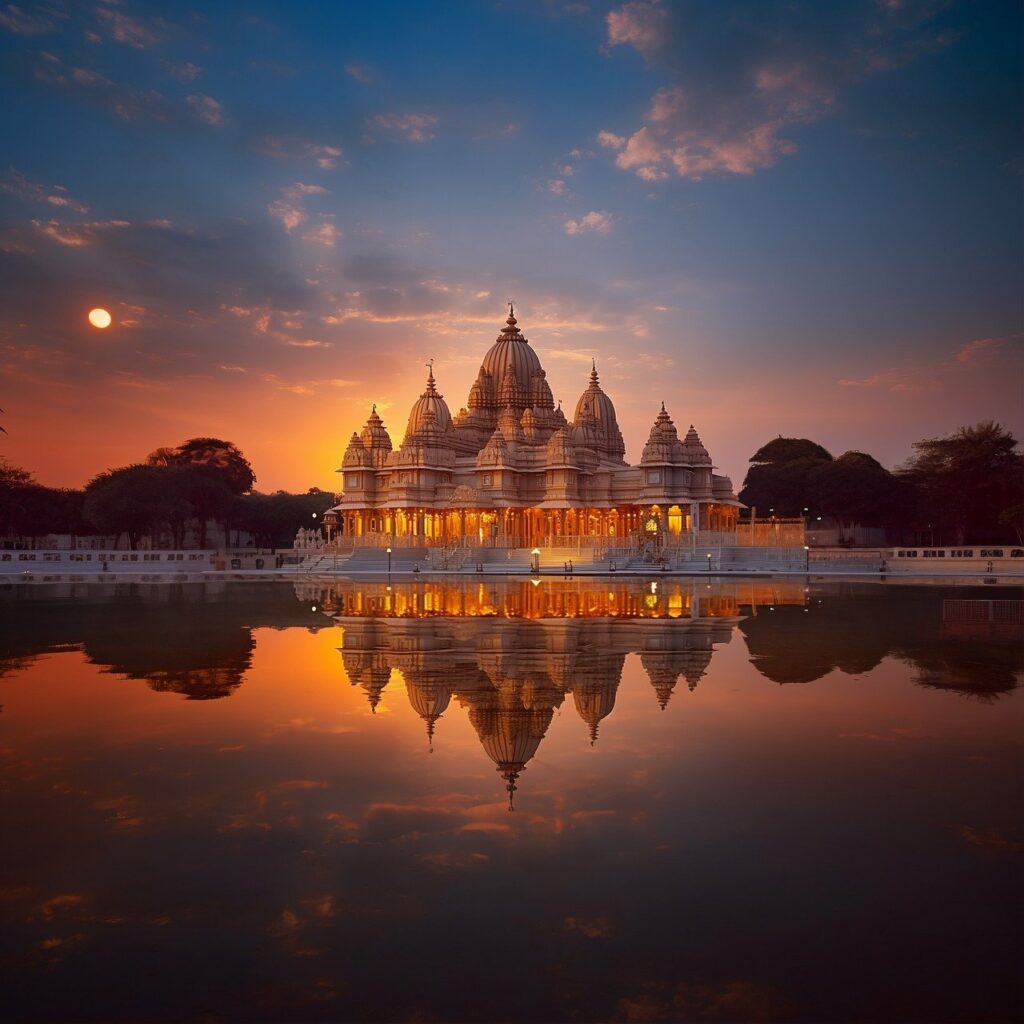
India, a land of myriad landscapes, rich history, and vibrant culture, is a traveler’s paradise. From the majestic Himalayas in the north to the serene backwaters of the south, India offers a treasure trove of experiences for every wanderlust soul. In this comprehensive guide, we delve deeper into the top 10 beautiful places in India, each offering its unique blend of natural beauty, cultural heritage, and adventure. Fine the India’s Top 10 Beautiful Places below.
- Taj Mahal, Agra:
Our journey begins with the iconic symbol of love and architectural marvel, the Taj Mahal, located in the city of Agra, Uttar Pradesh. Built by Mughal Emperor Shah Jahan in memory of his beloved wife Mumtaz Mahal, this white marble mausoleum is a UNESCO World Heritage Site and one of the Seven Wonders of the World. The Taj Mahal’s ethereal beauty, with its intricate carvings, exquisite inlays, and perfectly symmetrical gardens, is a testament to the timeless love story that transcends generations.
Visitors can immerse themselves in the history and romance of the Taj Mahal as they stroll through its pristine gardens, admire the intricate calligraphy of Quranic verses adorning its walls, and witness the changing hues of the marble monument at sunrise and sunset. A visit to the Taj Mahal is not just a sightseeing experience but a journey into the heart of India’s rich cultural heritage and architectural grandeur.
- Kashmir Valley, Jammu and Kashmir:
Next on our list is the breathtakingly beautiful Kashmir Valley, often referred to as “Paradise on Earth.” Nestled amidst the Himalayas, this enchanting region is renowned for its pristine beauty, serene lakes, and snow-capped peaks. Whether it’s the picturesque Dal Lake, where visitors can embark on a shikara ride amidst floating gardens and historic houseboats, or the lush Mughal Gardens with their vibrant flower beds and cascading fountains, Kashmir captivates visitors with its natural splendor.
Adventure enthusiasts can indulge in a host of outdoor activities, including trekking amidst the towering peaks of Gulmarg and Sonmarg, skiing in the snow-clad slopes of Pahalgam, and white-water rafting in the gushing rivers of Lidder and Jhelum. The Kashmir Valley’s timeless beauty and warm hospitality make it a must-visit destination for travelers seeking tranquility amidst nature’s grandeur.
- Jaipur, Rajasthan:
Step into the vibrant world of Rajasthan’s capital city, Jaipur, often referred to as the “Pink City” due to its terracotta-colored buildings. This princely city is a treasure trove of royal heritage, architectural marvels, and colorful bazaars that beckon visitors to embark on a journey back in time.
One of Jaipur’s most iconic landmarks is the Amber Fort, a majestic hilltop fortress known for its imposing ramparts, intricate marble carvings, and sweeping views of the surrounding landscape. Visitors can also explore the opulent City Palace, which houses a fascinating museum showcasing royal artifacts, textiles, and artworks, and marvel at the intricately designed Hawa Mahal, or Palace of Winds, with its lattice windows and honeycomb façade.
Beyond its architectural splendor, Jaipur offers a vibrant cultural scene, with lively folk performances, traditional Rajasthani cuisine, and bustling markets selling everything from handcrafted textiles to precious gemstones. A visit to Jaipur is a sensory delight, where every street corner reveals a story of Rajasthan’s rich heritage and royal legacy.
- Backwaters of Kerala:
Escape to the tranquil backwaters of Kerala, a network of interconnected canals, rivers, and lakes that meander through lush greenery and swaying palms. The backwaters, particularly in Alleppey (Alappuzha) and Kumarakom, offer a serene retreat from the hustle and bustle of city life, where visitors can unwind aboard traditional houseboats known as kettuvallams.
Cruise along the palm-fringed waterways, passing by quaint villages, verdant paddy fields, and coconut groves, as the gentle lapping of water soothes your senses. Watch as local fishermen cast their nets and women wash clothes along the banks, offering a glimpse into the rhythms of everyday life in rural Kerala.
As the sun sets over the horizon, painting the sky in hues of orange and pink, enjoy a sumptuous meal prepared by your onboard chef, featuring fresh seafood and traditional Kerala delicacies. The backwaters of Kerala offer a truly immersive experience in nature’s tranquility, where time seems to stand still amidst the timeless beauty of the landscape.
- Goa:
Experience the laid-back charm and vibrant culture of India’s smallest state, Goa, renowned for its golden beaches, historic churches, and lively nightlife. Nestled along the Arabian Sea on the western coast of India, Goa’s unique blend of Portuguese heritage and Indian tradition gives it a distinct character that sets it apart from the rest of the country.
Whether you’re seeking relaxation on the pristine sands of Calangute, Baga, and Palolem beaches, exploring the UNESCO-listed churches and colonial-era architecture of Old Goa, or dancing the night away at one of the many beach shacks and clubs, Goa offers something for every traveler.
Beyond its beaches and parties, Goa is also a haven for food lovers, with its diverse culinary scene featuring fresh seafood, spicy vindaloo curries, and fusion dishes that blend Portuguese and Goan flavors. Explore the bustling markets of Mapusa and Anjuna, where you can shop for souvenirs, handicrafts, and local delicacies, or embark on a spice plantation tour to learn about Goa’s rich culinary heritage.
With its relaxed vibe, scenic beauty, and vibrant culture, Goa captures the essence of tropical paradise and beckons visitors to unwind, explore, and immerse themselves in the laid-back charm of India’s coastal gem.
- Leh-Ladakh, Jammu and Kashmir:
Journey to the rugged landscapes and remote valleys of Leh-Ladakh, a region of unparalleled beauty and adventure nestled in the northernmost reaches of India. Surrounded by the towering peaks of the Himalayas and Karakoram ranges, Leh-Ladakh is a land of stark contrasts, with barren deserts, azure lakes, and ancient Buddhist monasteries dotting its landscape.
One of the highlights of a visit to Leh-Ladakh is the breathtaking Pangong Lake, a shimmering expanse of turquoise waters set against a backdrop of snow-capped mountains. Visitors can camp by the lake’s shore, marveling at the changing colors of the water as the sun rises and sets, or embark on a trek to explore the surrounding valleys and hidden monasteries.
For adventure enthusiasts, Leh-Ladakh offers a range of outdoor activities, including trekking along the Markha Valley, mountain biking across rugged terrain, and white-water rafting in the fast-flowing rivers of Zanskar and Indus. The region’s unique blend of natural beauty, cultural heritage, and adventure makes it a bucket-list destination for travelers seeking off-the-beaten-path experiences amidst the pristine landscapes of the Himalayas.
- Ranthambore National Park, Rajasthan:
Embark on a wildlife safari adventure in Ranthambore National Park, one of the largest and most renowned national parks in India, located in the state of Rajasthan. Spread across dense forests, rocky terrain, and open grasslands, Ranthambore is home to a diverse array of wildlife, including the majestic royal Bengal tiger, leopards, sloth bears, and a variety of bird species.
Visitors can explore the park’s rugged terrain aboard open-air jeeps and canters, accompanied by experienced guides who help spot elusive wildlife and provide insights into the park’s ecosystem and conservation efforts. Keep your eyes peeled for sightings of tigers prowling through the undergrowth or deer grazing peacefully in the meadows, as the thrill of encountering wildlife in its natural habitat is an experience like no other.
Apart from its wildlife, Ranthambore is also steeped in history, with ancient ruins and fortifications scattered throughout the park, including the formidable Ranthambore Fort perched atop a rocky hill. Explore the park’s rich heritage as you uncover the stories of its past rulers and marvel at the architectural wonders that stand as testaments to Rajasthan’s royal legacy.
- Varanasi, Uttar Pradesh:
Immerse yourself in the spiritual heart of India with a visit to Varanasi, one of the oldest continuously inhabited cities in the world, located on the banks of the sacred River Ganges in Uttar Pradesh. Varanasi, also known as Kashi or the City of Light, is a place of pilgrimage and devotion, where ancient traditions and rituals continue to thrive amidst the chaos of modern life.
At the heart of Varanasi’s spiritual allure is the ghats, or riverfront steps, where devotees gather to perform sacred rituals, offer prayers, and take holy dips in the waters of the Ganges to cleanse their sins and attain salvation. Experience the mesmerizing Ganga Aarti ceremony, where priests clad in saffron robes offer prayers to the river goddess, accompanied by chanting, music, and the glow of oil lamps as they float down the river.
Explore Varanasi’s labyrinthine lanes, lined with ancient temples, bustling markets, and vibrant street vendors selling everything from silk saris to fragrant incense. Visit the historic Kashi Vishwanath Temple, dedicated to Lord Shiva, and the Sarnath Stupa, where Buddha is said to have delivered his first sermon, to delve deeper into the city’s rich spiritual heritage.
- Munnar, Kerala:
Nestled amidst the mist-covered hills of the Western Ghats, Munnar is a picturesque hill station in Kerala renowned for its sprawling tea plantations, lush forests, and cascading waterfalls. Situated at an altitude of 1,600 meters above sea level, Munnar’s cool climate and verdant landscapes make it a popular destination for nature lovers and honeymooners alike.
Explore the lush greenery of Munnar’s tea estates, where rows of emerald-green tea bushes carpet the hillsides, creating a mesmerizing sight against the backdrop of mist-shrouded mountains. Visitors can take guided tours of tea factories to learn about the tea-making process, from plucking the leaves to processing and packaging, and sample a variety of aromatic brews.
For outdoor enthusiasts, Munnar offers a range of trekking trails that wind through verdant forests, meandering streams, and panoramic viewpoints, offering breathtaking vistas of the surrounding valleys and peaks. Visit the Eravikulam National Park, home to the endangered Nilgiri Tahr, a rare mountain goat species, and explore the pristine beauty of Anamudi, the highest peak in South India.
- Andaman and Nicobar Islands:
Embark on a tropical island adventure in the Andaman and Nicobar Islands, an archipelago of over 500 islands scattered in the Bay of Bengal. Blessed with palm-fringed beaches, crystal-clear waters, and vibrant coral reefs, the Andaman and Nicobar Islands offer a paradise-like setting for beach lovers, divers, and nature enthusiasts.
Explore the pristine beaches and turquoise lagoons of Havelock Island, where you can swim, snorkel, or simply relax on the powdery white sands, soaking in the sun’s rays and the gentle sea breeze. Dive into the underwater world of Neil Island, where colorful coral reefs teem with marine life, including tropical fish, sea turtles, and reef sharks, making it a haven for scuba diving and snorkeling enthusiasts.
For history buffs, a visit to the historic Cellular Jail in Port Blair offers insights into the islands’ colonial past, with its stark reminders of the British era and the sacrifices made by freedom fighters during India’s struggle for independence. Explore the island’s rich biodiversity at the Chidiya Tapu Biological Park, home to a variety of endemic bird species, and embark on a trek through the lush rainforests of Mount Harriet National Park for panoramic views of the surrounding islands and coastline.
Conclusion:
India’s top 10 beautiful places offer a glimpse into the country’s diverse landscapes, rich cultural heritage, and unparalleled natural beauty. From the iconic monuments of Agra and the serene backwaters of Kerala to the rugged landscapes of Leh-Ladakh and the tropical paradise of the Andaman and Nicobar Islands, each destination beckons travelers with its unique charm and allure.
Whether you’re seeking spiritual enlightenment in the sacred city of Varanasi, embarking on a wildlife safari adventure in Ranthambore National Park, or simply unwinding on the sun-kissed beaches of Goa, India promises unforgettable experiences that will leave you enchanted and inspired. So pack your bags, embark on a journey of discovery, and immerse yourself in the splendor of Incredible India.
Question: What is the significance of the Taj Mahal in Agra?
Answer: The Taj Mahal is a symbol of love and architectural brilliance, built by Mughal Emperor Shah Jahan in memory of his beloved wife Mumtaz Mahal. It is one of the Seven Wonders of the World and a UNESCO World Heritage Site.
Question: What makes the Kashmir Valley a popular tourist destination?
Answer: The Kashmir Valley is renowned for its pristine beauty, serene lakes, and snow-capped mountains. It offers activities such as shikara rides on Dal Lake, trekking in Gulmarg, and exploring ancient Mughal gardens.
Question: Why is Jaipur known as the “Pink City”?
Answer: Jaipur is called the “Pink City” due to the terracotta-colored buildings that adorn its streets. It is a treasure trove of royal heritage and architectural marvels, including the majestic Amber Fort and the intricately designed Hawa Mahal.
Question: What makes the backwaters of Kerala a unique attraction?
Answer: The backwaters of Kerala are a network of interconnected canals, rivers, and lakes lined with swaying palms and lush greenery. Visitors can cruise on traditional houseboats, indulge in Ayurvedic therapies, and witness mesmerizing sunsets over the serene waters.
Question: What is the appeal of Goa as a tourist destination?
Answer: Goa is famous for its golden beaches, vibrant nightlife, and Portuguese heritage. Visitors can relax on pristine beaches, explore historic churches and forts, and indulge in water sports and seafood cuisine.
Question: What makes Leh-Ladakh a popular destination for adventure enthusiasts?
Answer: Leh-Ladakh is renowned for its surreal landscapes, rugged mountains, and Buddhist monasteries. Adventure seekers can trek through the Markha Valley, camp by the Pangong Lake, and indulge in mountain biking and white-water rafting.
Question: What wildlife can be spotted in Ranthambore National Park?
Answer: Ranthambore National Park is home to the royal Bengal tiger, leopards, sloth bears, and a variety of bird species. Visitors can embark on jungle safaris to spot wildlife and explore ancient ruins and fortifications scattered throughout the park.
Question: What spiritual experiences can one have in Varanasi?
Answer: Varanasi is a sacred city on the banks of the Ganges River, known for its ghats and ancient temples. Visitors can attend the mesmerizing Ganga Aarti ceremony, explore labyrinthine lanes lined with temples, and witness the rituals of life and death along the riverbanks.
Question: What attractions can visitors explore in Munnar, Kerala?
Answer: Munnar is known for its sprawling tea plantations, mist-covered hills, and cascading waterfalls. Visitors can trek through tea estates, visit the Eravikulam National Park to spot Nilgiri Tahrs, and immerse themselves in the tranquility of nature.
Question: What makes the Andaman and Nicobar Islands a tropical paradise?
Answer: The Andaman and Nicobar Islands are blessed with palm-fringed beaches, crystal-clear waters, and vibrant coral reefs. Visitors can snorkel or dive to explore underwater ecosystems, relax on pristine beaches, and learn about the islands’ colonial history at sites like the Cellular Jail in Port Blair.

